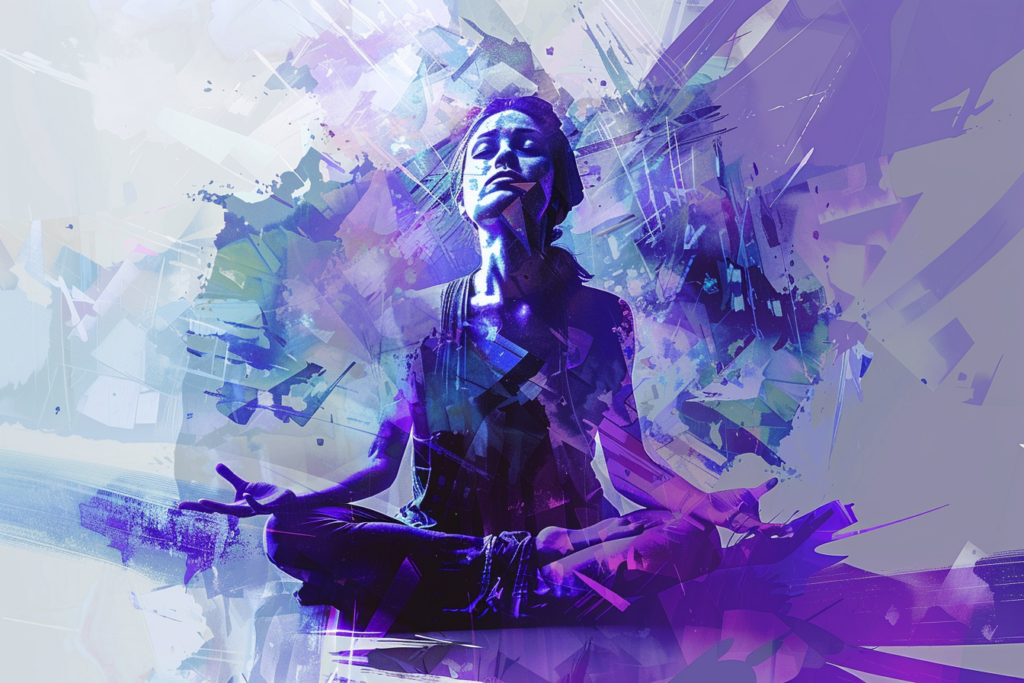Self-Hypnosis for Beginners: A Step-by-Step Guide
Hypnosis is surrounded by many myths. One of them being: you have to be deeply into spirituality, to get into hypnotic trance. That’s simply not true. Auto-hypnosis is a skill like any other. While self-hypnosis for beginners might sound intimidating, it’s someting anyone can master.
What is Self-Hypnosis? An Introduction for Beginners
I’ve covered the basic of auto-hypnosis HERE, so I’ll keep it short. It’s a practice to put yourself in a state of hypnotic trance, while being both a hypnotizer and a hypnotized person.
Self-hypnosis for beginners might seem complicated or even mystic. But it’s not.
Just disregard all you might know about hypnosis from pop-culture and focus on the scientific side. Auto-hypnosis is a little bit similar to meditation, but it has some key differences, like:
- Self-hypnosis is usually oriented towards a particular goal.
- Auto-hypnosis works faster in achieving certain states of mind.
- Effects of meditation and hypnosis vary.
However, if you have experience with deep meditation, it’s possible you’ve already experienced trance state.
But what exactly is trance? I like the definition my mentor was once said, that states:
Trance is a state of mind in which your internal world feels more real than the external one
And in that state of mind, you can work with your subconsciousness to “hack” yourself.
How to Prepare for Your First Auto-Hypnosis Session
Self-hypnosis for beginners might be problematic. That’s because we tend to blame ourselves if we don’t succeed in that and set unrealistic goal for our first session.
Think of it that way: can you learn a handstand in one training? Probably not.
Or maybe you’re a master chief after a single culinary course? I guess not.
So why demand from yourself to be perfect at hypnosis after the first session?
Attitude is a key to learning auto-hypnosis. Don’t go into it with huge expectations, ready to completely transform life in one go.
Instead, treat it with curiosity. Ask yourself questions, wonder about what’s going to happen, let go off expectations. At the same time, don’t overthink it and just do it once you feel ready.
Prepare yourself a nice, comfy and quiet place. The less distractions, the better, however don’t close yourself in a sterile room. That’s actually distracting for a lot of us.
For the first self-hypnosis as an amateur, the best position would be seated with support. Sit on a couch or on the floor with something to support your back.
Lying down is great, but it’s easy to fall asleep in the beginning.
With both mental and physical preparation, you are more than ready to go.
Relaxation Techniques to Ease into a Hypnotic State
Keep in mind, please, that self-hypnosis for beginners takes more time than for advanced people. I’d advise starting with relaxation techniques, before jumping straight into a hypnotic state.
Why? Because the more relaxed your body is, the easier it is to achieve trance.
There are many techniques that you can use. Personally, I like simple “body travel”. It goes like this:
- Regulate your breathing.
- With each inhale, imagine the energy, that soothes your muscles.
- With each exhale, imagine black smoke and tensions, leaving your body.
- Start with your feet. Feel how heavy they are, how they relax with each breath.
- Move into your calves. Feel the tension leaving.
- Once you reach your hips, relax both legs.
Once you reach your head, finish with an autosuggestion like, “My whole body is perfectly relaxed.”
It shouldn’t take you more than 5–10 minutes. Once you reach trance state, you are going to be even more relaxed anyway.
Entering the Hypnotic State with Self-Hypnosis
Once you are relaxed, you can start the actual auto-hypnosis. The first session of self-hypnosis for beginners might go like this:
- Focus your gaze on one, simple thing that you can clearly see.

My safe space during hypnotic trance is usually a sandy beach. What’s yours? - While breathing slowly, use first autosuggestion. Tell yourself that with each inhale, your eyelids are more relaxed, and with each exhale they are getting heavier.
- Once you close your eyes, focus on breath. Notice, where the air goes in, and how it’s leaving your body.
- Imagine walking down 5 steps (or other number if you prefer). Use autosuggestion like, “With each step, my body is more relaxed, and my mind is more focused.”
- Once you are down, imagine a door. Tell yourself, “Behind those doors lies my perfect safe space/safe heaven.”
- (optional) Before opening the door, feel what’s behind them. For example: if your safe space is the beach, hear the waves and seagulls.
- Use autosuggestion “I’m counting from 5 to 1. With each count, I’m closer to my perfect safe space. Once I reach 0, I open the door and find myself in my zone.”
- Start counting as fast or as slow as you desire to. Keep in mind the autosuggestion from the previous step.
- When you reach 1, open the door and find yourself in your zone.
- Visualize everything you can with all five senses. Feel what’s under your feet, smell the air, taste the water, look around you, hear the birds.
- After you feel accustomed to that space, use another autosuggestion. Anchor that state of mind with specific gesture and words. For example: stick your thumb and middle finger of left hand and say three times “safe heaven.”
- Use autosuggestion, “I can always return here whenever I want.”
- Spend here as much time as you want. Don’t force yourself into anything, and just explore the zone with the curiosity of a child.
- Slowly tell yourself to go back to reality. Don’t rush and count from 1 to 5 (or whatever other number you like). With each count, you can tell yourself suggestions like “I feel my arms getting lighter”, “I notice the surrounding sounds.”
- Once you return to your body, take some time to feel it once again.
That’s basics self-hypnosis for beginners. You might have noticed that there is no specific goal here. There is a reason for that.
Setting certain goals might be distracting and make your first session harder. That’s not to say you can’t go with a goal into hypnotic trance. Quite the contrary.
However, for the first time I’d recommend just trying to reach safe zone and… well, vibing there.
Achieving Goals with Hypnotic Trance
The first auto-hypnosis serves as a way to get accustomed to the whole technique. With the second one, go with a specific goal in mind. For example: creativity.
Let’s say you are an artist. You have a certain thing to finish, but something feels lacking, and you need the sparkle of artistic flow.
Then try self-hypnosis for beginners, but this time: keep it shorter. Just use your favorite relaxation technique and once you feel ready, use your anchor.
Stick your thumb and middle finger of the left hand, and say three times “safe heaven.”
Once you reach your zone, you can work with your goal. Keeping it with creativity, imagine yourself working on your art.
What exactly do you want to create?
Is it something big or small?
What emotions do you feel when you look at the finished piece of art?
Remember: focus on what you feel once your work is done. Feel the emotions, the happiness, the proud. Don’t focus on the process, but the final art.
Additionally, try to incorporate as many details as you can. The paint on your hands, pieces of the song you just composed, fragments of your book.
The deeper you are in your visualization, the better the effects of auto-hypnosis.
Why I Can’t Get Into Hypnotic Trance?
Self-hypnosis for beginners isn’t easy. Though the effects of hypnosis are faster than meditation, journaling or other mindfulness techniques, you have to first get into trance.
And that is something that is not easily done.
Moreover, you can get frustrated if you don’t get into it. Which in turn creates another problem: you might get prejudiced towards hypnosis.
So what can you do if you can’t get into a hypnotic trance on your own? Well, you need help to get your anchor.
How do you that?
- Make a recording – using autosuggestions often feel weird, if you are an amateur. Thus, you can record them and use them while on your session. This way you still perform auto-hypnosis, but with a help of technology!
- Get hypnotized by someone – this one is pretty self-explanatory. Go to a professional and speak with him/her about hypnosis. Preferably: go to someone, who also teaches self-hypnosis.
- Use guided hypnosis – this is a great idea if you want to start fast and are low on budget. Just go with video/recording, ‘install’ the anchor, and then you can work on your own.
If you want to start ASAP, I recommend going with the third option. You can find videos with titles like ‘self-hypnosis for beginners for courage/creativity/good sleep’.
However, I’d recommend something simple. Just a recording, that will allow you to get into hypnotic trance. Later on, you will learn to achieve various goals via hypnosis.
For now: keep it simple. And if you want to install that kind of anchor, you can check out my free recording HERE.
Playing with Your Inner Child
By now, you know a lot about self-hypnosis. You can also read my other articles on that and if you found recording about auto-hypnosis that suit you—you are ready to go!
With that being said, please remember to treat everything with curiosity. Self-hypnosis for beginners is just a start of your journey.
With time, you will learn more advanced techniques.
Explore the depths of your subconscious mind and unlock it’s potential.
Unleash your creativity, natural talents, charisma.
The key to all of that is curiosity. Even when everyone says you should ‘be adulting’, when exploring your mind, be a child.
With that naive, yet beautiful curiosity, explore what’s going on inside you.
Why did your safe heaven change after two weeks?
Who did you encounter while chilling in your inner world?
What do you feel like working with, depending on the day or time?
The results might surprise you!
And remember: you are doing it always for yourself, not for anyone else. There is no need to impress somebody, you don’t have to rush anything.
Play with your inner child and uncover your true self.

